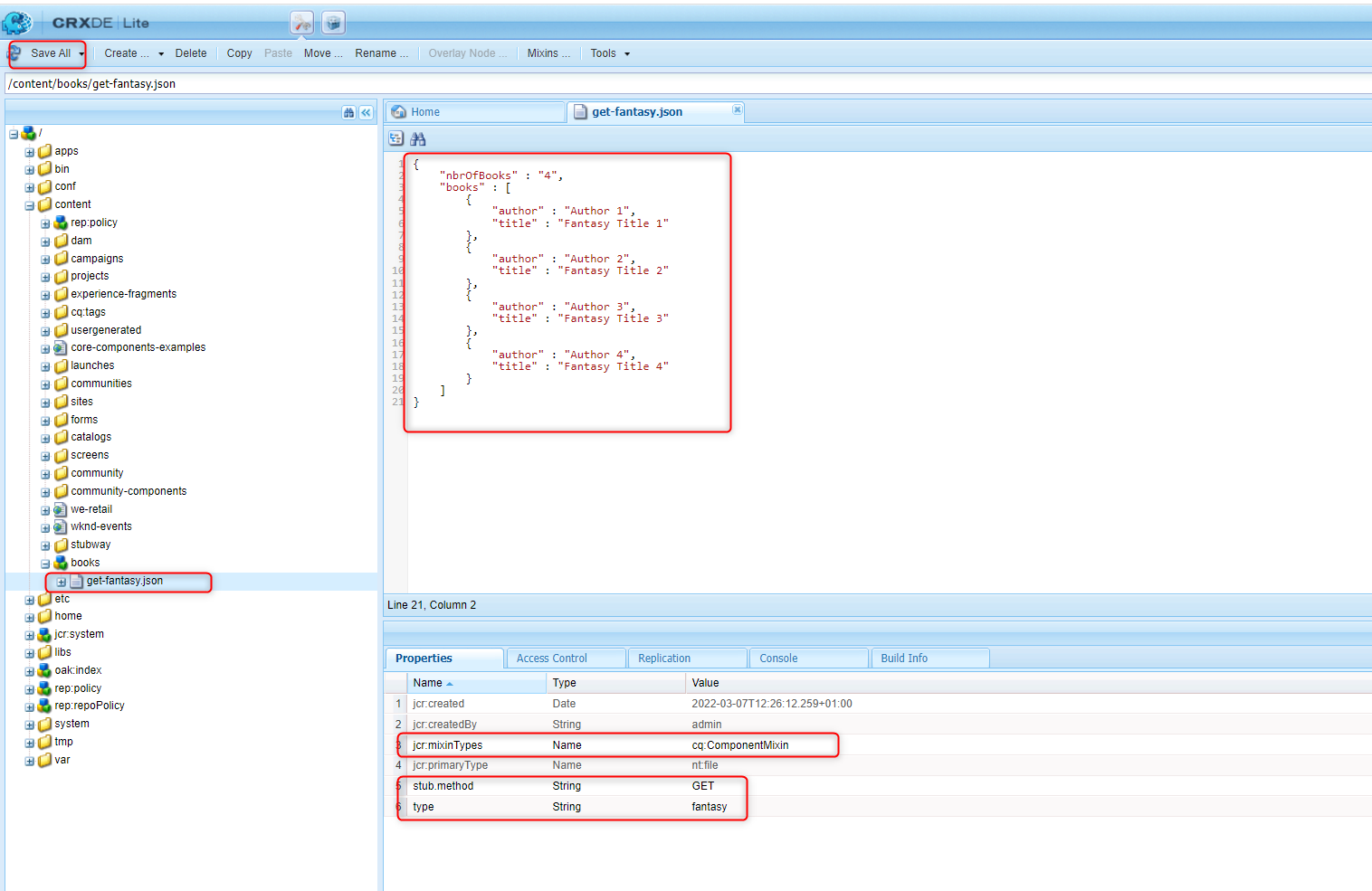Simple, easy-to-use and fast way to make tests stable.
Stubway allows less code-oriented people to easily create and maintain stubs for a specific request and response.
Stubway is a dependency free tool (Java code only) for AEM, used on platforms which restrict third party libraries and frameworks. This also makes Stubway easy to maintain and develop for anyone familiar with Java language.
To use Stubway:
- Install Stubway package on your AEM author and/or publish instance
- To get example stubs, install stubway.ui.content-.zip
- Start creating your own stubs!
To create GET REST response for request sent to http://localhost:4503/content/books
with one query parameter type=fantasy (http://localhost:4503/content/books?type=fantasy), you need to perform
the following steps:
Step 1. Go to CRXDE Lite http://localhost:4503/crx/de (NOTE: stubway is not accessible through /siteadmin view)
Step 2. Under /content create new node books (this name is important - it matches the path at REST endpoint)
and choose nt:unstructured in Type field.
Step 3. Add property sling:resourceType with value stubway/stub for /content/books node:
Step 4. Under /content/books node create new file get-fantasy.json (file name is irrelevant)
Step 5. Click on get-fantasy.json and put content of json file. This will be the GET REST response.
{
"nbrOfBooks" : "4",
"books" : [
{
"author" : "Author 1",
"title" : "Fantasy Title 1"
},
{
"author" : "Author 2",
"title" : "Fantasy Title 2"
},
{
"author" : "Author 3",
"title" : "Fantasy Title 3"
},
{
"author" : "Author 4",
"title" : "Fantasy Title 4"
}
]
}Add the following properties:
jcr:mixinTypes type: Name, value: cq:ComponentMixin
stub.method type: String, value: GET <-- this property indicates the method of REST request. It can have the following
values: GET, POST, PUT, DELETE (coming more in future).
type type: String, value: fantasy <-- this property matches the query parameter type. fantasy value will match
?type=fantasy requests
You may also use regular expression patterns as the value of the property. To indicate that the value of a specific property should be treated as a regex pattern and matched against the value of the named URL query parameter, you must add the ".regex" suffix to the property name:
type.regex type: String, value: ^hist.*$ <-- this property matches the query parameter type. ^hist.*$ value
will match both ?type=history or ?type=historical fiction requests.
When the body of a request is in JSON format, you may create properties to match values inside the JSON data, by simply adding the "body." prefix to the property name:
body.language type: String, value: English <-- this property matches a JSON key with name language and value
English in the body of the request.
You also have the option to specify values to be included or replaced in the response headers. Response headers are identified with the "stub.res." prefix and may refer to standard HTTP headers or custom proprietary ones:
stub.res.Server type: String, value: Stubway/1.0.0 <-- this property will include the Server HTTP header in the
response. The value of the header will be Stubway/1.0.0.
Save the changes.
Step 6. Test your new stub.
In REST client (i.e. Postman), run GET request: http://localhost:4503/content/books?type=fantasy
You should receive json response as it was configured in previous step:
You can create stubs returning any HTTP Status Code (https://restfulapi.net/http-status-codes/)
stub.statusCode property with proper value in the file node. For example, if you want your stub to return
401 (Unauthorized):
Find more examples under /content/stubway (provided in stubway.ui.content-.zip package).
Please note that the stubs provided in that package will respond to requests with the following base URL:
http://localhost:4503/content/stubway/library/<endpoint>
Reflecting the full path of their respective nodes, as seen in CRXDE Lite
Before you start creating your own stubs, make sure that you have:
- Java 8 or higher installed,
- Maven installed,
- AEM 6.4.X or higher up and running.
Go to the project root directory and run the following command with Maven 3:
mvn clean install
When AEM instance is up, build and deploy the whole package using the following command:
mvn clean install -PautoInstallPackage
To deploy it to a publish instance, run:
mvn clean install -PautoInstallPackagePublish
Alternatively run:
mvn clean install -PautoInstallPackage -Daem.port=4503
The maven execution should complete with success status, listing all the deployed bundles:
[INFO] ------------------------------------------------------------------------
[INFO] Reactor Summary for Stubway 1.0.0:
[INFO]
[INFO] Stubway ............................................ SUCCESS [ 0.355 s]
[INFO] Stubway - Core ..................................... SUCCESS [ 3.224 s]
[INFO] Stubway - UI apps .................................. SUCCESS [ 0.716 s]
[INFO] Stubway - UI content ............................... SUCCESS [ 0.594 s]
[INFO] Stubway - All ...................................... SUCCESS [ 0.316 s]
[INFO] ------------------------------------------------------------------------
[INFO] BUILD SUCCESS
[INFO] ------------------------------------------------------------------------
To deploy only one of those bundles to the author instance, go the respective folder and run:
mvn clean install -PautoInstallBundle
Go to "how to test" documentation.
Do you have any questions? Have you found a bug?
Raise it using a proper issue template. We will do our best to get back with a quick reply.
Do you want to contribute?
That's amazing! See our Contributing guide to get started.
Stubway project is licensed under the terms of the Apache 2.0 license.





